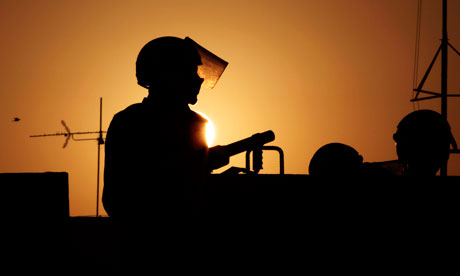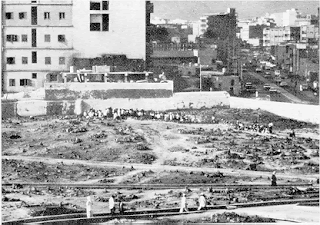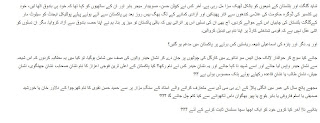Much has been written on this blog as to why the attacks on the Shias, Barelwi Sunnis, Sufi/Shia/Sunni shrines, imambargahs, muharram processions, and mosques must not be thought of as a "Sunni-Shia" conflict. For one, often the same sectarian groups are behind these attacks. Moreover, there are broader political interests attached to these militant activities (consider for instance the factors involved in 2009 Karachi Ashura bombing; see here and here). Some of these sectarian groups are also linked to the anti-Pakistan Taliban groups, which have also attacked the military and police bases in Pakistan. They are said to have been involved in attacks on political parties as well. While other Taliban groups -- the "good" Taliban -- are still protected by the rogue elements of the state's security agencies. These groups have also aligned themselves with other sectarian outfits.
Within the above context, consider these two pieces of evidence.
1. An Ahle Hadith Cleric Gunned Down; One Militant Caught
This militant was not Shia. Yet in the simplistic numerical aggregations of some journalistic accounts, the killed cleric, belonging to the Sunni Ahle Hadith school, would be categoried as a "Sunni" and the event as a "Sunni-Shia" conflict. Too often this is how the so-called "sectarian" violencde has been viewed. See in this previous post how the 2006 Nishtar Park bombing was blamed on the Shias by a foreign journalist.
http://tribune.com.pk/story/475750/deserted-by-friends-fleeing-suspect-caught-by-mob/
KARACHI (Dec 6, 2012): A target killer was caught red-handed by seminary students after his accomplices escaped but his motorcycle stalled as he tried to flee after killing a cleric in New Karachi.
The prayer leader-cum-seminary teacher of Jamia Masjid-o-Madressa Islamia, Qari Ahsanullah Rasheed, was shot dead on Wednesday evening while he was teaching Quran to the students, Bilal Colony police said.
Three armed men came to the mosque on a motorcycle, witnesses said. One of the three entered the mosque and shot the victim in the head, killing him on the spot. When he went outside, he saw his accomplices had already escaped. He tried to kick-start the motorcycle but as a mob approached him, he started running. He also fired at the crowd, injuring a man in the shoulder, SP Salman Hussain, the New Karachi division police chief, told The Express Tribune. The killer was then handed over to the police.
The accused was later identified as Kashif Shakoor alias Bilal, who lives in Quaidabad. During interrogation, the assassin said he was associated with a militant outfit. “He was directed by someone from Waziristan to kill the victim on suspicion of being a police informer,” said the SP citing the suspect.
The victim, Qari Rasheed, had been associated with the mosque for the past 15 years. The killer and his victim both were from the Ahle Hadith sect, said SP Hussain.
Unconfirmed reports suggested they were also associated with the Jamaatud Dawa but its spokesperson denied, saying the organisation had no links with the mosque, its administration or the men.
Earlier, a young man was shot dead at his car showroom on Shaheed-e-Millat Road, Ferozabad police said. Two armed men on a motorcycle shot Tanvir Hussain Bangash, 28, twice, killing him on the spot, said ASP Ghulam Murtaza Malik. The victim, father of one, lived in PECHS and belonged to the Shia sect.
Suspected militants arrested
A potential attack on an imambargah in Gulshan-e-Iqbal was averted as two suspects allegedly associated with the banned religious outfit, Lashkar-e-Jhangvi (LeJ), were arrested on Tuesday night, Azizabad police said.
Five men in a high-roof vehicle were asked to stop by police in Block-2, Federal B Area but they started firing. After an encounter, Hafiz Hanif and Qari Chiraghuddin were arrested while three of their accomplices escaped, the police said.
The police have identified the other suspects as Qari Ghulam Mohammad, Qari Ghulam Akbar and Riaz. The law enforcers are conducting raids in different neighbourhoods in search of the other alleged militants.
During interrogation, the men admitted they were associated with the LeJ as well as Harkatul Mujahideen and were planning to attack an imambargah in Gulshan-e-Iqbal through an explosives-laden vehicle, said DSP Saleem Akhtar Siddiqui. The suspects were trained in Kandahar, Afghanistan.
The suspects were also involved in collecting funds for their organisations through donations and selling skins of sacrificial animals.
Published in The Express Tribune, December 6th, 2012.
2. A Sectarian Militant Killed in Quetta; belonged to the Levies Force
On September 30, 2012, two gunmen attacked a jewelry shop owned by a Shia Muslim, Abdul Khaliq, in Quetta’s Liaquat Bazar. Khaliq was injured in the attack. The shop's private security guard returned fire and killed one gunman, while the other escaped. The gunman was identified as Mujeeb-ur-Rehman, a sepoy in Balochistan Levies, a paramilitary force, who was posted in Balochistan's Sherani district. In another case, a gunned down attacker turned out to be a part of an anti-terrorism task force. It is rare that an attacker would be killed or captured. But these two cases are sufficient to consider that the anti-Shia outfits have deep penetration and connections. At times, those captured have also been able to "escape" from jail. For instance, two high profile militants, Usman Saifullah Kurd and Shafeeq Rind, had escaped from a tightly secured jail of Anti-Terrorist Force in the Quetta Cantonment area.
Abdul Khaliq, the shop owner in the above case, was a Qandhari Shia. In the last few years, the sectarian outfits have indiscriminately killed hundreds of Shias from Hazara, Qandhari, Punjabi, Saraeki, and other ethnic backgrounds in Balochistan. Over 100 Shias have been killed in 2012 alone.
Within the above context, consider these two pieces of evidence.
1. An Ahle Hadith Cleric Gunned Down; One Militant Caught
This militant was not Shia. Yet in the simplistic numerical aggregations of some journalistic accounts, the killed cleric, belonging to the Sunni Ahle Hadith school, would be categoried as a "Sunni" and the event as a "Sunni-Shia" conflict. Too often this is how the so-called "sectarian" violencde has been viewed. See in this previous post how the 2006 Nishtar Park bombing was blamed on the Shias by a foreign journalist.
http://tribune.com.pk/story/475750/deserted-by-friends-fleeing-suspect-caught-by-mob/
KARACHI (Dec 6, 2012): A target killer was caught red-handed by seminary students after his accomplices escaped but his motorcycle stalled as he tried to flee after killing a cleric in New Karachi.
The prayer leader-cum-seminary teacher of Jamia Masjid-o-Madressa Islamia, Qari Ahsanullah Rasheed, was shot dead on Wednesday evening while he was teaching Quran to the students, Bilal Colony police said.
Three armed men came to the mosque on a motorcycle, witnesses said. One of the three entered the mosque and shot the victim in the head, killing him on the spot. When he went outside, he saw his accomplices had already escaped. He tried to kick-start the motorcycle but as a mob approached him, he started running. He also fired at the crowd, injuring a man in the shoulder, SP Salman Hussain, the New Karachi division police chief, told The Express Tribune. The killer was then handed over to the police.
The accused was later identified as Kashif Shakoor alias Bilal, who lives in Quaidabad. During interrogation, the assassin said he was associated with a militant outfit. “He was directed by someone from Waziristan to kill the victim on suspicion of being a police informer,” said the SP citing the suspect.
The victim, Qari Rasheed, had been associated with the mosque for the past 15 years. The killer and his victim both were from the Ahle Hadith sect, said SP Hussain.
Unconfirmed reports suggested they were also associated with the Jamaatud Dawa but its spokesperson denied, saying the organisation had no links with the mosque, its administration or the men.
Earlier, a young man was shot dead at his car showroom on Shaheed-e-Millat Road, Ferozabad police said. Two armed men on a motorcycle shot Tanvir Hussain Bangash, 28, twice, killing him on the spot, said ASP Ghulam Murtaza Malik. The victim, father of one, lived in PECHS and belonged to the Shia sect.
Suspected militants arrested
A potential attack on an imambargah in Gulshan-e-Iqbal was averted as two suspects allegedly associated with the banned religious outfit, Lashkar-e-Jhangvi (LeJ), were arrested on Tuesday night, Azizabad police said.
Five men in a high-roof vehicle were asked to stop by police in Block-2, Federal B Area but they started firing. After an encounter, Hafiz Hanif and Qari Chiraghuddin were arrested while three of their accomplices escaped, the police said.
The police have identified the other suspects as Qari Ghulam Mohammad, Qari Ghulam Akbar and Riaz. The law enforcers are conducting raids in different neighbourhoods in search of the other alleged militants.
During interrogation, the men admitted they were associated with the LeJ as well as Harkatul Mujahideen and were planning to attack an imambargah in Gulshan-e-Iqbal through an explosives-laden vehicle, said DSP Saleem Akhtar Siddiqui. The suspects were trained in Kandahar, Afghanistan.
The suspects were also involved in collecting funds for their organisations through donations and selling skins of sacrificial animals.
Published in The Express Tribune, December 6th, 2012.
2. A Sectarian Militant Killed in Quetta; belonged to the Levies Force
On September 30, 2012, two gunmen attacked a jewelry shop owned by a Shia Muslim, Abdul Khaliq, in Quetta’s Liaquat Bazar. Khaliq was injured in the attack. The shop's private security guard returned fire and killed one gunman, while the other escaped. The gunman was identified as Mujeeb-ur-Rehman, a sepoy in Balochistan Levies, a paramilitary force, who was posted in Balochistan's Sherani district. In another case, a gunned down attacker turned out to be a part of an anti-terrorism task force. It is rare that an attacker would be killed or captured. But these two cases are sufficient to consider that the anti-Shia outfits have deep penetration and connections. At times, those captured have also been able to "escape" from jail. For instance, two high profile militants, Usman Saifullah Kurd and Shafeeq Rind, had escaped from a tightly secured jail of Anti-Terrorist Force in the Quetta Cantonment area.
Abdul Khaliq, the shop owner in the above case, was a Qandhari Shia. In the last few years, the sectarian outfits have indiscriminately killed hundreds of Shias from Hazara, Qandhari, Punjabi, Saraeki, and other ethnic backgrounds in Balochistan. Over 100 Shias have been killed in 2012 alone.











